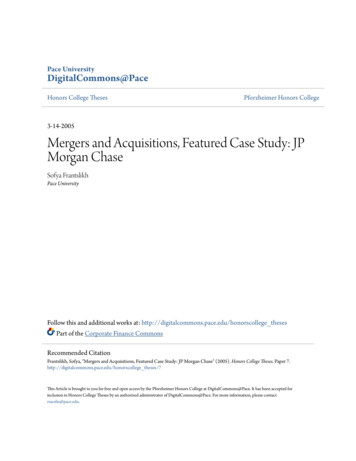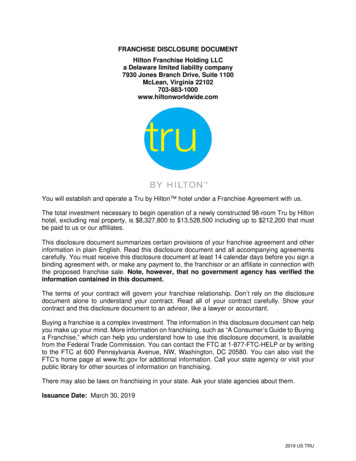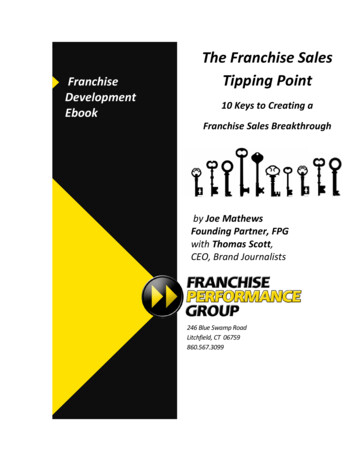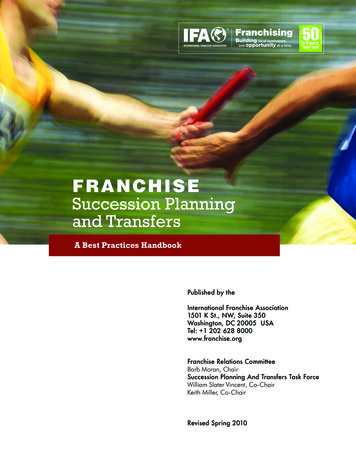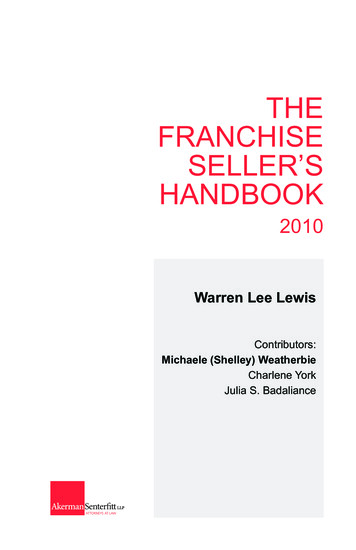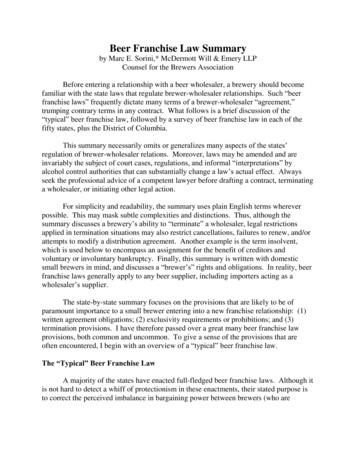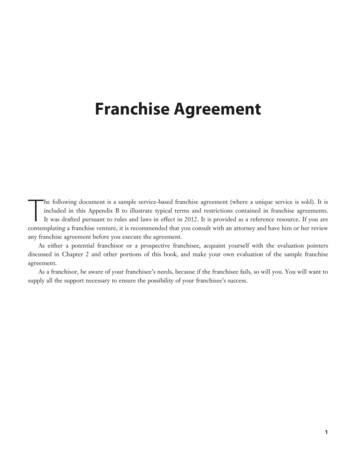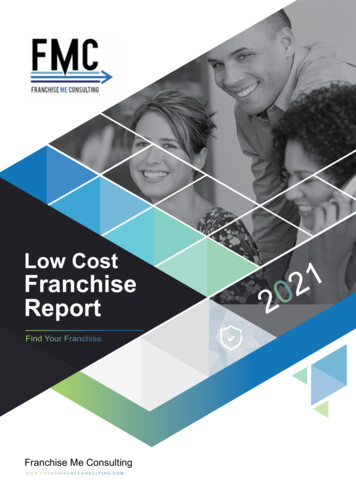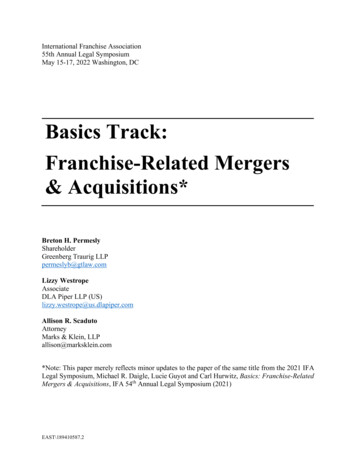
Transcription
International Franchise Association55th Annual Legal SymposiumMay 15-17, 2022 Washington, DCBasics Track:Franchise-Related Mergers& Acquisitions*Breton H. PermeslyShareholderGreenberg Traurig LLPpermeslyb@gtlaw.comLizzy WestropeAssociateDLA Piper LLP (US)lizzy.westrope@us.dlapiper.comAllison R. ScadutoAttorneyMarks & Klein, LLPallison@marksklein.com*Note: This paper merely reflects minor updates to the paper of the same title from the 2021 IFALegal Symposium, Michael R. Daigle, Lucie Guyot and Carl Hurwitz, Basics: Franchise-RelatedMergers & Acquisitions, IFA 54th Annual Legal Symposium (2021)EAST\189410587.2
TABLE OF CONTENTSPAGEA.Introduction . 1B.Overview of Deal Process . 11. Who’s Buying . 12. Preparing for Sale . 23. Assessing Valuation and Working with an M&A Advisor . 24. Basic Deal Structure – Stock vs. Assets . 25. Letter of Intent . 36. Buyer Due Diligence. 37. Seller Investigation of Buyer . 38. Purchase Agreement . 49. Closing the Deal . 410. Franchise Sales Issues During the Deal Process . 4C.1.2.3.4.5.6.7.Preparing to Sell a Franchise Company . 5Assess the Franchise Agreements . 5Secure Intellectual Property Rights . 5Resolve Litigation and Reduce Potential Claims. 6Shore up the Sales Process . 7Enhance the Legal Underpinnings for Growth . 7Evaluate Royalty Stream and Opportunities for System Growth . 7Never Too Early to Start – Franchisor Best Practices to Assure a Smooth Sale Down theRoad . 8D.Assessing Valuation . 81. Royalty Stream. 82. Same-Store Sales Growth . 83. Company-Owned Contribution. 84. Franchisee Profitability . 95. Franchisee Payback . 96. Franchisee Tenure and Renewal Rates . 97. Franchisee “Class” Data . 98. Franchisee Pipeline . 99. Competitive Landscape . 1010. Technology Systems . 1011. Litigation . 1012. Cyclicality of the Business/End-Markets.Error! Bookmark not defined.13. Capital Expenditures . 1014. Franchisor vs. Franchisee Valuations . 10E.Letter of Intent . 11EAST\189410587.2i
F.Franchise Sales Issues and Suspension and Amendment Concerns During the Deal Process. 11G.Goals of Each Party in Conducting Due Diligence. . 131. Buyer’s Potential Goals . 132. Seller’s Potential Goals . 13H.Buyer’s Due Diligence Process . 141. Establishing Realistic Goals that are Deal-Specific. 142. Stages of Due Diligence. 143. Sending Out the Due Diligence Checklist . 144. Preliminary Due Diligence Call with Seller . 155. Assessing the Strength of the Franchise System’s Intellectual Property . 156. Analyzing the Strength of the Franchise (and Related) Agreements . 177. Gauging Compliance with Franchise Sales and Relationship Laws/Practices . 218. Joint Employer Concerns . 249. Vicarious Liability Risk . 2410. Understanding Purchasing and Supply Chain Issues . 2511. Talking to Stakeholders . 2512. Cross-Border Issues . 2613. Data . 26I.1.2.3.4.5.J.Purchase Agreement Negotiations: How the Due Diligence Process can Impact theTransaction . 26Franchise Representations and Warranties . 27Sample Franchise Representations . 27Representations and Warranties Insurance . 29Reductions to Price; Minimizing Risk with Seller Indemnifications, Holdbacks andEscrows; Covenants . 29Keeping A Hand In – A Note on Roll-Over Equity, Earn-Outs and Post- ClosingEmployment/Consulting Agreements . 29Conclusion . 30Exhibit A: Sample Franchise Due Diligence ChecklistExhibit B: Sample Franchise Representations and WarrantiesCOVID-19 SupplementEAST\189410587.2ii
A.Introduction. For many years, the market has witnessed strong interest in the acquisition ofcompanies which own and operate franchise systems. Although the industry has seen asignificant increase in acquisitions of large, multi-unit franchisee businesses, we will focuson the transfer of entire franchise systems, i.e. the selling of the franchise brand, orfranchisor, itself. This paper gives an overview of the deal process, examining franchisespecific issues. It first examines what a seller of a franchise company should consider inreadying itself for sale to optimize the company’s franchise value. It also looks at themetrics investment bankers and sophisticated buyers use to assess valuation. Next, it turnsto the deal itself, including reaching a letter of intent and conducting the critical duediligence that a prudent buyer should follow before closing the transaction. Finally, itreviews key components of the purchase agreement and what the seller and buyer canexpect. Although this paper is generally limited to the pre-closing process, we consider thepre-acquisition and post-acquisition disclosure obligations of the seller and buyer, as wellas ways for a selling owner-manager to stay involved in the business. For additionalinformation on this topic, there have been a number of IFA articles and presentations duringthe past several years, 1 and they have been excellent sources in developing this paper.B.Overview of Deal Process. Who are the players and what needs to happen to accomplishthe sale of a franchise system? Below is an overview of the deal process. A more detaileddiscussion of the topics follows in later sections of this paper.1.Who’s Buying. Since the rebounding of the overall market since the late 2000s, thefranchise industry has enjoyed strong interest and many franchise brands have beentransferred to either strategic buyers or financial sponsors.(a)Strategic buyers—those who are already in the franchise industry orbusiness sector—often seek to add units and market share by capturingcompeting or similar brands, or brands that target the same consumer strata.For example, the parent company of Arby’s Restaurant Group formedInspire Brands and acquired the Buffalo Wild Wings and Sonic brandsin 2018 and the Dunkin and Baskin-Robbins brands in 2020; in October2019, the owners of Huddle House, Inc. acquired the Perkins Restaurant &Bakery brand. Franchisees can be another type of strategic buyer, often insituations where turn-around strategies are important to a strugglingsystem. 2See Sandra Bodeau and Meg Montague, Basics: Franchise-Related Mergers & Acquisitions, in IFA 49TH ANNUALLEGAL SYMPOSIUM, (2016); Gaylen Knack, Grayson Brown, Jeremy Holland, Looking Under the Hood:Conducting Due Diligence in Franchise Transactions, in IFA 47TH ANNUAL LEGAL SYMPOSIUM, W14 (2014);P. Thao Le, Reeves McGee, Breton Permesly, Basics: Franchise-Related Mergers and Acquisitions; in IFA 47THANNUAL LEGAL SYMPOSIUM (2014); Mark Kirsch, Scott Pressley and Patrick Walls, A Seller’s Guide toPreparing to Sell the Franchise System, in IFA 42ND ANNUAL LEGAL SYMPOSIUM (2009); Victoria Blackwelland Kevin P. Hein, The Fundamentals of an M & A Transaction in a Franchise System, in ABA 33RD ANNUALFORUM ON FRANCHISING, Tab W18 (2010).2In 2012, a group of franchisees from Long John’s Silver’s and another group from A&W purchased franchise systemsfrom YUM! Brands. In 2021, Flynn Restaurant Group acquired 937 Pizza Hut restaurants and 194 Wendy’s outletsfrom NPC International. NPC International was formerly the country’s largest Pizza Hut and Wendy’s franchisee,with 1.6 billion in sales from its 1,229 Pizza Hut and 393 Wendy’s restaurants at the end of 2019. However, after1EAST\189410587.2
(b)Financial sponsors, such as private equity firms seeking strong investmentsfor their fund portfolios, are attracted to the long-term royalty streams orproduct distribution capabilities of franchise companies. For example,Cleveland Avenue became a strategic partner and majority investor in PizzaRev, TZP took a stake in Snap Fitness, BIP Investment Partners purchasedTropical Smoothie Café, and Catterton recently acquired the fast-growingPure Barre franchise system.2.Preparing for Sale. The seller will need to lay the legal groundwork to be ready tosell. This includes assessing the franchise agreements, confirming ownership of orsecuring all necessary intellectual property rights, resolving potential claims,solidifying relationships with key franchisees, evaluating the sales process anddeveloping a clear message on future growth opportunities, such as by addingcomplementary services, revamping marketing initiatives, and seeking expansioninternationally. This exercise is sometimes referred to as “seller due diligence.”3.Assessing Valuation and Working with an M&A Advisor. The seller will want tomeet with an experienced M&A financial advisor, such as an investment banker, tofind ways to maximize value. These advisors will run through typical factors thatdrive a premium valuation for the company. The M&A advisor will conductinternal information-gathering and prepare marketing materials to distribute topotential buyers. If a seller is in a strong bargaining position, investment bankerscan bring substantial additional value to the sale by canvassing these potentialbuyers and, in some cases, conducting an auction process.4.Basic Deal Structure – Stock vs. Assets. The seller will want to consider itspreferred sale structure in consultation with its tax, legal and M&A advisors. As innon-franchise M&A transactions, the seller often prefers to sell the equity securitiesof the franchise company, rather than have the franchise company sell its assets, forvarious reasons, including liability (in an equity sale, all of the company’s assetsand liabilities stay with it, and so accrue to the buyer), comparative simplicity oftransfer (less need for third-party consents and approvals in an equity deal) and taxconsiderations (real estate transfer and other sales taxes can be avoided in an equitydeal, thus preserving more value for the parties, and the seller may be able to shelterits capital gains from the stock sale). Buyers, on the other hand, sometimes preferasset deals, where they can cherry-pick assets and liabilities, as well as seller’semployees.In a “stock” deal structure, the transfer of the equity securities of the target may bethrough a direct sale of the securities or by merger. In a direct sale of securities, allowners of the target would be parties to the purchase agreement and would agreeto sell their securities to the buyer. If the target has a large number of equity ownersongoing financial struggles, which were exacerbated by the arrival of the pandemic in March 2020, NPC Internationalfiling for bankruptcy in July 2020. Flynn Restaurant Group became the largest franchisee group in the United Statesas a result of the acquisition.EAST\189410587.22
or some equity owners who may not voluntarily want to sell their securities, a directsale may be burdensome or impractical.In those instances, a merger is the legal method to accomplish a stock deal. In amerger, the parties to the transaction are the entities involved (and likely keyowners), rather than all of the securities holders. So long as the target entity obtainsthe requisite approvals, state law would subject all equity holders to the transaction,subject to any dissenters’ or appraisal rights. Thus, the merger structure allows thebuyer to acquire the target without each target equity holder agreeing to sell itssecurities to the buyer.The most common merger structure is where a wholly-owned subsidiary of thebuyer (referred to as the merger sub) merges with and into the target and the target,as the surviving entity in the merger, would become a wholly owned subsidiary ofthe buyer. The consideration is paid by the buyer to the equity holders of the target.This structure allows for the target entity to continue as a legal entity and continueits operations post-merger.As noted above, some may prefer an asset sale over a stock sale because the buyercan select which assets it will purchase and which liabilities it will assume. Theasset transaction may be preferable in some respects but may be more complicatedbecause consents of third parties and regulatory authorities may be required.5.Letter of Intent. The M&A advisor will normally require that each possible buyersign a confidentiality/non-disclosure agreement covering the information it willreceive to evaluate the deal. Interested prospective buyers will be asked to submitand negotiate a letter of intent (LOI) addressing key financial and legal terms of thecontemplated transaction.6.Buyer Due Diligence. The scope of due diligence will depend on whether thetransaction is structured as a stock or asset sale, or a merger; the speed andcomplexity of the transaction; the awareness of target personnel of the pendingtransaction; the geographic scope of the target’s franchise network (includingextent of international operations); how a buyer intends to conduct the business oruse the assets after the closing; and other related issues. Depending on the type ofbuyer, the seller may wish to limit the scope of the buyer’s due diligence. Inparticular, the seller may need to restrict access to confidential information for astrategic buyer who is a competitor in order to minimize any advantage thecompetitor could gain if the deal falls through.7.Seller Investigation of Buyer. In addition to the due diligence described above, theseller should also perform an investigation and analysis of the proposed buyer,especially with regard to its financial wherewithal (and hence its ability to close thetransaction) as well as its reputational and operational suitability as a partner, if theseller or its principals are planning to retain a level of involvement post-closing orif the seller is receiving a material amount of the purchase price post-closing.EAST\189410587.23
8.Purchase Agreement. Typically, the LOI contemplates that the parties will sign a“definitive agreement”, which means a negotiated merger or purchase agreement,within a stated time period, or lose exclusivity. This allows the seller the ability tomove on if the buyer is moving too slowly but gives the buyer some time to gets itsdue diligence completed. Often, in an auction situation run by the seller’s M&Aadvisor, the seller’s preferred form of purchase agreement will be posted to a dataroom and bidders will need to submit a mark-up together with their bids. This canlead buyers to be very conservative in their agreement mark-up, fearing that heavyrevisions would negatively impact the attractiveness of their bids. The purchaseagreement is usually negotiated concurrently with due diligence. The negotiationsof the purchase agreement will focus on a comprehensive set of representations andwarranties related to the franchise business, as well as conditions to the closing andthe covenants of the parties. In addition, the indemnification provisions, includingthe determination of any “dollar one” liabilities and other liabilities subject to abasket, and the cap on liabilities will be negotiated. The results of the due diligencewill feed into the negotiations, as the buyer will seek more favorable terms andmore risk reducing provisions in the purchase agreement if the buyer’sinvestigations reveal potential or actual material post-closing liabilities.9.Closing the Deal. With nearly all asset deals, and with most stock deals or mergers,the purchase agreement will be signed with the expectation that the actual transferof the target company (i.e., the closing of the transaction) will occur at a later date.During the time period between signing of the purchase agreement and closing ofthe transaction — typically 30-60 days (but with substantial variations) — theparties will seek any third-party consents required to transfer the assets or business.At some point in the selling process, the parties will want to consider how thepending transaction should affect the target company’s franchise sales. Also, thebuyer will want to prepare amendments to the franchise disclosure document (FDD)in a stock deal, and create its own FDD in an asset deal, in order to minimize thetime period where franchise sales will need to go “dark” (i.e., the franchisor willstop selling franchises) after the closing.10.Franchise Sales Issues During the Deal Process. Both federal and state lawsregulating franchising focus on providing prospective franchisees with materialinformation regarding the franchise being purchased. These laws generally requirean FDD amendment when there is a material change in the information presentedin the currently effective FDD. The guidelines under which the FDDs are prepareddo not specifically address disclosure obligations with respect to a pending sale ofa franchise system. 3 Nevertheless, the required disclosures may be impacted by thepending sale and, depending on the circumstances, common law may requiredisclosure of a potential or pending transaction. The seller and buyer will want toconsider a number of business and legal concerns to determine how to address thisHarris J. Chernow and Charles S. Modell, Mergers and Acquisition of Franchise Companies, ABA PUBLISHING,Second Edition (2014) (Vines, Leonard D and Noyes, Christina M., Editors), at 29-33.3EAST\189410587.24
disclosure issue. See Section F of this paper for a more detailed discussion of salesuspension and FDD amendment considerations during the deal process.C.Preparing to Sell a Franchise Company. The heightened interest in the market regardingthe franchise sector has sparked interest in selling, especially with owners approachingretirement age and looking for a liquidity event. Sections C and D of this paper highlightkey legal and valuations issues for the seller to consider in the sale of a franchise systemand the proactive steps the seller can take to improve the franchise system’s purchase price.Preparation includes reducing liabilities, addressing franchisee performance, and headingoff other issues that may negatively affect the purchase price.1.Assess the Franchise Agreements. 4 The seller’s franchise agreements are contractrights that often represent, along with its trademarks, the franchise company’s mostvaluable assets. Savvy buyers will review the franchise agreements in depth todetermine the quality and reliability of the royalty stream they are purchasing. Toprepare for this review, a seller should track the various versions of the franchiseagreements in use in the system and make note of any significant variations amongthem. The seller should create a log of each version of the franchise agreement,noting key changes among versions, especially in royalty and other fees and rightsgranted or reserved.In addition, legal counsel should review whether the franchise agreements give thefranchisor flexibility in responding to dynamic changes in the marketplace. Can thefranchisor update the system, add new product or service lines, change suppliers,and add products or services that could not have been anticipated when thefranchise system was first developed? Can the franchisor change the trademark? Ifthe answer to any of these questions is “no”, then the franchisor will need toconsider changing its franchise agreement form going forward and addressing theseconcerns under its existing franchise agreements. Are there franchise agreementswhere the territory granted is too large, creating an impediment to future expansion?If so, the franchisor may want to negotiate with the franchisee to reduce or split upthe territory.As franchises come up for renewal, if permitted under the existing franchiseagreements, the franchisor should require that the franchisees renew on thefranchisor’s then-current form of franchise agreement. If older versions are notsoon up for renewal and have little flexibility, lower fee structures, or othertroublesome provisions or omissions, the franchisor should consider embarking onan incentive program to encourage franchisees to enter into the newest version offranchise agreement. These steps will bring welcome flexibility and standardizationto the system and make the franchisor more attractive as an acquisition target.2.Secure Intellectual Property Rights. 5 Imagine taking the franchise name off retailunits and trying to promote the business. Picture a competitor setting up shop withSandra Bodeau, John Brower & Gaylen Knack, Selling the Franchise System: Laying the Legal Groundwork toOptimize Value, FRANCHISING WORLD, April 2013 at 66-68.5Id. at 66.4EAST\189410587.25
the same trade dress and a confusingly similar name across the street.Understandably, buyers will closely examine the strength of the seller’s trademarkand other intellectual property rights because such rights form the foundation of thefranchise system. If the franchisor has failed adequately to protect and police itstrademarks, or if there are other legal concerns regarding the ownership or validityof its intellectual property rights, the franchisor’s value will be seriously affected.Consequently, the seller should conduct an audit of its intellectual property. Theseller should create a list of all intellectual property it uses or licenses, and evaluatethe strength, validity and status of its intellectual property, including both tradesecrets and intellectual property that is subject to registration in variousjurisdictions. The seller should determine if there are any concerns, and thenestablish a game plan to address those concerns. Whether the franchisor follows upwith cease and desist letters to infringers or takes a more conciliatory approach witha third-party who may hold conflicting rights to the trademark, the franchisorshould attempt to resolve as many of these conflicts as possible before going tomarket.3.Resolve Litigation and Reduce Potential Claims. 6 Significant ongoing or threatenedlitigation can cast a cloud over the value of a company. Because a buyer often willevaluate such litigation on a worst-case basis, ongoing litigation, proceedings orthreats against the franchisor can disproportionately reduce the valuation given tothe franchise system. Moreover, a buyer may insist on being indemnified againstthe litigation in the purchase agreement and such liability may be outside of anycap or basket. When this occurs, the seller will be put in the undesirable position ofhaving significant liability exposure post-closing, often without the ability to fullycontrol the litigation. Because of these factors, a seller who is a party to significantlitigation against it should maximize efforts to get the litigation resolved beforeembarking on the sale of its business.Sellers should take steps to reduce the risk of future lawsuits from franchisees andother third parties. As a defense against claims, the seller may wish to establish aproactive, comprehensive release program. A release of liability signed by afranchisee for the benefit of the franchisor frees the franchisor from most franchiseeclaims for damages resulting from a breach of the franchisor’s duties and from otherclaims the franchisee may pursue against the franchisor. Eliminating potentialclaims at every opportunity will reduce buyer concerns about exposure tofranchisee claims and limit the seller’s exposure if the seller providesindemnification against such claims in the purchase agreement. One note ofcaution, however -- not all franchise laws in all jurisdictions permit releases ofclaims under those laws.As is emphasized in greater detail below, when preparing for or conducting aninternational transaction, it is essential to obtain the advice of local counsel to help6Id. at 67.EAST\189410587.26
determine the risks inherent in the proposed transaction and to determine what can,and cannot, be done to minimize those risks.4.Shore up the Sales Process. 7 Each seller should conduct a comprehensive franchisesales compliance audit before bringing the franchisor to market. This sales auditwill determine whether the franchisor’s sales force has followed franchisedisclosure and registration laws consistently. Do all FDD receipts document thatthe franchisor has followed proper compliance procedures? Have franchiseescomplained about unauthorized financial performance representations or promisesmade outside the contract? Upon finding non-compliance issues, the seller shouldimplement compliance training and other tools (e.g. checking for FDD receipts,adopting closing acknowledgements, and seeking releases) to minimize futureissues and to cleanse past missteps.5.Enhance the Legal Underpinnings for Growth. 8 One of the most significant factorswhich boosts a franchisor’s valuation is a buyer’s belief that it can significantlyexpand the franchisor’s business after the purchase. The seller should do as muchas it can to establish the legal underpinnings for this growth potential. One focuscan be the provisions of existing franchise agreements. The seller should createsufficient flexibility in its
Legal Symposium, Michael R. Daigle, Lucie Guyot and Carl Hurwitz, Basics: Franchise-Related Mergers & Acquisitions, IFA 54th Annual Legal Symposium (2021) i EAST\189410587.2. . considerations (real estate transfer and other sales taxes can be avoided in an equity deal, thus preserving more value for the parties, and the seller may be able to .


